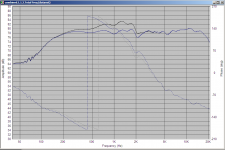If a crossover is designed to operate several drivers at certain crossover frequencies, what affect does it have on the operation of the crossover to replace those drivers with drivers of different impedance than the original? Is the result only to shift the impedance seen at the input of the crossover, or do the crossover frequencies shift also?
xover freqs shift.
also some xovers have things like frequency compensation built in... not all, but some.
there are some freeware xover simulators and of course LTSpice. LTSpice will give you a real world look at what it is doing. Plus you could plug in a generalized speaker simulation netword and get even closer, but that is overkill.
Start with a freeware or web based xover calculator to see what happens...
_-_-bear
also some xovers have things like frequency compensation built in... not all, but some.
there are some freeware xover simulators and of course LTSpice. LTSpice will give you a real world look at what it is doing. Plus you could plug in a generalized speaker simulation netword and get even closer, but that is overkill.
Start with a freeware or web based xover calculator to see what happens...
_-_-bear
Let's say you have a three way with an 8 Ohm woof, a 4 ohm mid, 8 ohm tweet. Typically the four ohm mid-range is going to be more efficient...Say 89 db woofer, 92 db mid, 89 db tweeter. The response will have a "hot-spot" in the mid-range...un-acceptable. Besides messing up the cross-over slopes, the amp will be working "harder" within these ranges.
I agree with Bear here whole-heartedly, Get some software to design with, it makes it a whole lot easier so you don't have to grind thru the math. Your select program can do it instantly. Just plug in the values for your selected drivers!!!
______________________________________________________Rick........
I agree with Bear here whole-heartedly, Get some software to design with, it makes it a whole lot easier so you don't have to grind thru the math. Your select program can do it instantly. Just plug in the values for your selected drivers!!!
______________________________________________________Rick........
A picture is worth a thousand words they say. Below is the sim of my MTM's crossover The blue trace is with the real impedance of the M's the black is what happens when I double the impedance of the M's (back to what a single M would be)
I unfortunately haven't got the actual measured response here on my work laptop, but if I did it would show that the sim is accurate.
Tony.
edit: It's not quite what I would have expected, but this isn't a simple crossover, consisting of two notches and a pseudo 2nd order electrical on the M's The bit that really surprises me is that the response above 2600 Hz is barely effected, on in that the crossover point is 2800, but checking the transfer function for just the M's shows that it is correct.
I unfortunately haven't got the actual measured response here on my work laptop, but if I did it would show that the sim is accurate.
Tony.
edit: It's not quite what I would have expected, but this isn't a simple crossover, consisting of two notches and a pseudo 2nd order electrical on the M's The bit that really surprises me is that the response above 2600 Hz is barely effected, on in that the crossover point is 2800, but checking the transfer function for just the M's shows that it is correct.
Attachments
Last edited:
- Status
- This old topic is closed. If you want to reopen this topic, contact a moderator using the "Report Post" button.
